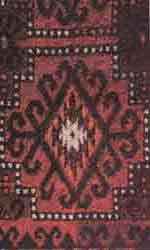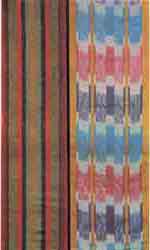Designing fabrics is a remarkable phenomenon of popular art in Uzbekistan.
From the second half of the 19-century various plain and patterned hand-made
cotton fabrics, silk and half-silk clothe with simple and intricate
interlacing were made in Margilan, Namangan, Buhara, and Andijan. They were
used to adorn dwellings and make clothes. Especially renowned were; close
velvet made of cotton and silk-bahmal, moire corded materials-adras, bekasab
and banoras, delicate and light silk kerchiefs-kalgai, rustling and playing
shoi-kanaus, atlas, yakruya and honatlas, which were of unique beauty,
original delicate patterns. These fabrics were mainly striped and patterned.
The main peculiarity is the illegibility and dimness of the outlines. In
Central Asia this device is called abrbandi, and the fabrics are known as
abr cloth.
The methods of making printed cloth are distinctive. The ornamented clot,
cotton in particular, was soaked with a solution of tannin, which in formed
times was imprinted on the cloth by hand with the use of a kolib- a wooden
dye.
Embroidery holds a special place on the popular art of Uzbekistan.
Supplementing other kinds of architectural and decorative arts such as ganch
(gypsum) and woodcarving, embroidered articles widely adorned dwellings and
small household articles. Embroidery was practiced on a large scale on
everyday and holiday dress.
The traditions of poplar carpet weaving in Uzbekistan are very ancient, and
arise from the creative search of many generations.
The are three types of carpets in Uzbekistan: carpets with short pile-gilam,
those with long pile julhirs, and palas.
The characteristic feature of carpets with short pile is their red-brown
tint, lit up by a harmony of light-colored details of the principal
medallions, which are frequently of geometrical form.








